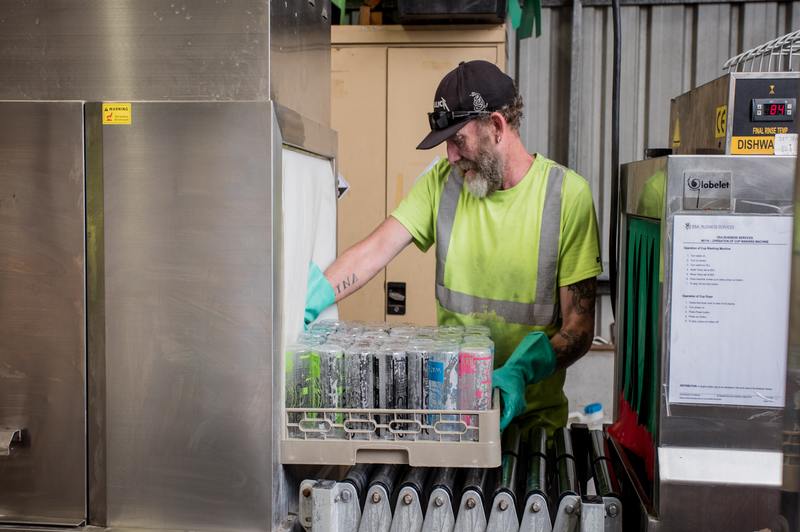Have you ever asked yourself, “Why is there mold in my dishwasher?” Read through and know the causes of mold growth in dishwashers and how to remove and prevent them.
Since your dishwasher is usually damp and warm, it becomes an ideal environment for mold. It is not just unpleasant to the eyes, it also poses a threat to your health. It is especially true given that the dishes you use for eating have chances of getting exposed.

Causes Of Mold In Dishwasher
There are three common causes of mold growth in your dishwasher. You must keep your eye on them to ensure no foreign organism will take over your precious home buddy.
1. Food particles
For mold and mildew to grow, they require nutrients. They get those from food particles left behind in your dishwasher. Plastic filters that collect these food particles must be cleaned regularly to avoid mold growth.
You can try running the dishwasher empty once a week to help get rid of unwanted food particles. Nonetheless, also check silverware baskets to make sure no food was trapped inside.
2. Moisture trapped in door gaskets
Door gaskets are usually not cleaned on regular wash cycles, causing moisture to get trapped. They become damp and prone to mold growth.
The thing is, the most prone areas are not visible. You will have to get the door gasket out to thoroughly clean and dry it.
3. Excessive moisture
A dry environment is not prone to mold growth, so if you want your dishwasher to be mold-free, ensure it is dried thoroughly before closing it. You can use the heat-dry function to get rid of all the moisture.
If you are to leave it idle for a while, it is better to keep it open. It is to keep any moisture from getting trapped inside it and stop mold from growing.
Guide To Killing Mold
Bleach has always been known as an effective weapon to get rid of mold. It is very convenient as it is readily available and also very easy to use.
Step #1. Dilute the bleach
Mix a cup of bleach and a gallon of water and put it in a pail or basin.
Step #2. Scrub the mold off your dishwasher
With a stiff brush and bleach solution, scrub off the mold and dirt in the interior of your dishwasher. You can also use your old toothbrush to get through and clean the narrow areas like the door gaskets. Make sure to use gloves when using bleach to protect your skin from irritation.
Step #3. Run the dishwasher empty
Once thoroughly scrubbed, run the dishwasher empty to rinse out all the bleach residue. Bleach is as harmful as a mold when it comes to your health, so make sure that the dishwasher is thoroughly cleaned and rinsed before using it.
For more tips on mold removal in dishwashers, you can check out this article. If you plan to use Concrobium Mold Control, here is a guide to help you with your DIY project. Learning how to use Concrobium Mold Control is essential in handling the potent chemical.
Preventing Mold In Dishwasher
Just like humans, your dishwasher needs a little TLC at times. Giving it a little attention will keep unwanted fungus away and ensure clean dishes. Here are some ways to do it.
Sanitize the door gasket
The rubber seal in your dishwasher door is the most prone to mold growth, so make sure to clean it regularly. You can use a toothbrush and soapy water to do it. Adding a bit of vinegar can also boost up its sanitizing power.
After cleaning, dry it completely with a clean cloth or paper towel. Please take note of this, or else it will start collecting germs all over again.
Clean the filler
Since food particles are one of the significant causes of mold growth in a dishwasher, you have to keep an eye on them. Plastic fillers collect these food particles, so make sure to clean them out on a regular basis. Giving it a good and tight scrub with soapy water once a week will be a good idea.
Thoroughly dry your dishwasher
To keep out mold, keep the moisture out of the picture. Make sure to completely dry out your dishwasher after every use to avoid mold build-up.
Rinse using vinegar and baking soda
Baking soda and white vinegar are known to be excellent non-toxic cleaning agents. Before running an empty wash, it will help if you spray the interior with a solution of water, vinegar, and baking soda. Taking out the racks and washing them separately will make cleaning more effective.
Conclusion
Dishwashers have got to be one of the most convenient inventions. Since it is often taken for granted, it is now the time for you to give them some care and attention.
Now the question of “why is there mold in my dishwasher?” has been answered, you now know better and will do better. As long as you take proper care of it properly, this home buddy will surely give you a hand in cleaning.
